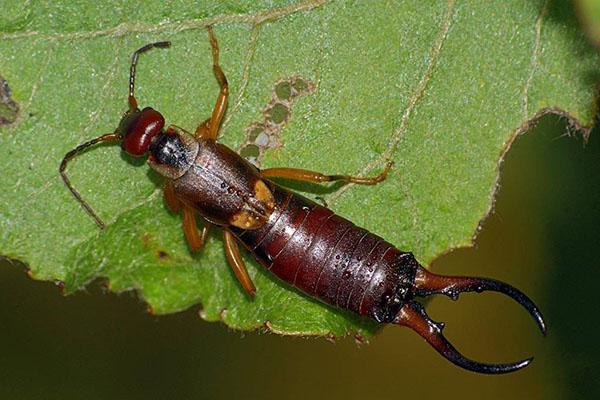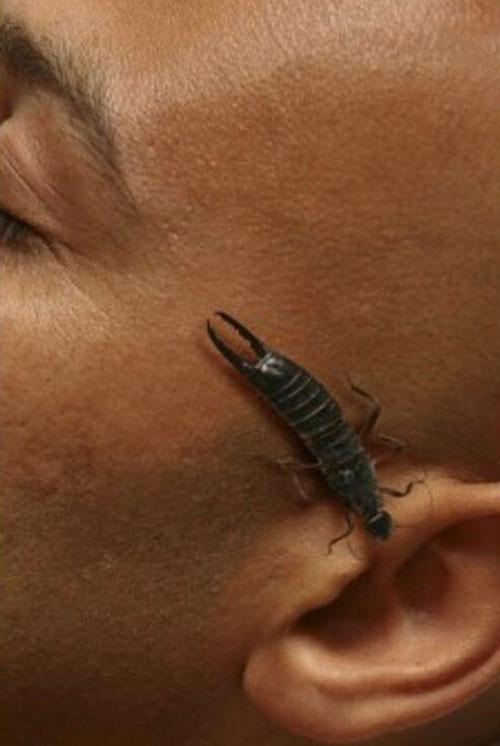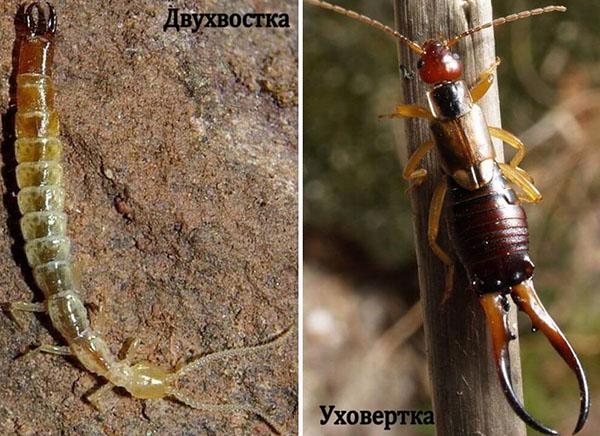Unpleasant neighbors: how to deal with earwigs in the garden and at home

The unpleasant-looking insect got its name from the belief that it has a habit of getting into the ears of a sleeping person. However, summer residents want to learn how to deal with earwigs in the garden and at home, not at all because of this mythical danger. A scary-looking insect can bring real harm when it reaches a sufficiently large number.
An earwig gets into the ears of a sleeping person no more often than other small insects, but in many European languages its name is associated with the word "Ear". It is possible that this is due to the shape of the wings, similar to the human ear.
Description

The earwig is a brown insect, with a flat, articulated body 2-3 cm long, covered with dense chitinous plates. Features of the structure of the earwig: on the tail there are two outgrowths in the form of ticks (cerci), whence the second name is two-tail.

When hunting or in self-defense, it bends its tail and holds its claws above its head like a scorpion. The shape and size of ticks differ even in individuals of the same species. During defense (earwigs themselves do not attack people), the insect can bite through the human skin. When hunting, it holds prey with tongs. In males, they are larger.
An earwig is often called a two-tailed earwig, but this is incorrect, since the latter belong to an independent order, and differ significantly from earwigs.
The ability to fly

Looking at an insect, you will never say that the earwig flies, since the wings are not visible. The front pair of wings is transformed into two short elytra, under which are hidden two webbed, fan-shaped transparent wings. Due to this structure of the earwig's wings, when folded, they are not visible, but if necessary, they quickly open. The process is similar to opening an automatic umbrella or manipulation by a magician who gets out of nowhere a bouquet of flowers.
The insect keeps its body upright during flight.

The unusual structure of the earwig's body - wings hidden from external influences, cerci in the form of pincers on the tail, a flexible articulated body - helped to survive for millions of years.
Types and distribution

About 490 species are described - representatives of the order of earwigs, most of which live in southern countries. There are 26 species in our country. The most common are "Ordinary" (among the people of the dvuhvostka), and "Coastal". "Ordinary" is found everywhere, "Coastal" in the southern part of the country, along the shores of water bodies, including the Black and Azov seas.
The latter is larger, has a more frightening appearance, but rarely settles in vegetable gardens. It is distinguished by its light color and large, sting-like, straight cerci on the tail.
Earwigs: a way of life

The insect is omnivorous, feeds on plants and their debris, mushrooms, and other insects. Earwigs live in damp places, under stones, boards and logs, under the bark of old trees and stumps. They live in groups. They are activated at dusk and at night (Asian, on the contrary, is active during the day). In apartments, in dachas or in private houses, she settles in damp places - under baths, in basements.
Earwigs: reproduction

At the end of summer, the female breaks a hole in the ground in the form of a tube up to 15 cm long, in which she lays eggs in a bunch. It hibernates with them, protects the nest until the larvae emerge from the eggs. Males usually die in winter. In spring, young earwigs emerge from the eggs, similar to adults, but smaller.The development of earwigs is considered incomplete because they do not go through the pupal phase (incomplete transformation). Insects live for about a year.
Why are earwigs dangerous?

Earwigs do not represent a great danger to humans. They can damage:
- flowers;
- seeds;
- sweet fruits;
- plant berries;
- seedlings;
- crawl into the house;
- spoil human food - bread, vegetables.
Enemies of beekeepers - penetrate the hives, where they feed on honey and bee bread. They cannot bite through the dense skin of the fruit; they gnaw out the pulp through already prepared holes made by other insects. In dry years, it can damage grain in storage. Cases of theft at picnics from a tablecloth spread on the ground, small pasta and noodles are described.
The "popular" name of the insect is a pincher, because during defense it can bite a person. The bite is not dangerous, the earwig is not poisonous. If this does happen, antiallergenic drugs ("Suprastin", "Diazolin") are taken.
In North America, it is considered a dangerous quarantine pest that can seriously damage crops. Their main fault in front of summer residents in our area is an unpleasant and repulsive appearance.
In addition to harm, they can also be beneficial, feeding on small harmful insects - aphids, whiteflies, destroying rotten fruits that have fallen to the ground. Before deciding how to deal with earwigs in your garden and home, consider the damage they cause. If the harm from them is not noticeable, it is better to leave them alone.
How to deal with earwigs in the garden and at home
When earwigs appear in an apartment, they should be fought with, as with any insects in a person's dwelling, but on the site they start a war only with an increase in their number.
In apartments

The pinch is an insect, and insecticides are used to combat it: karbofos, dichlorvos, "Mashenka" crayons. Pesticides are effective, but dangerous for humans, before use, you should carefully study the annotation.
When choosing an insecticide to combat earwigs in the garden and at home, it should be borne in mind that in the instructions for use, the earwig may not be indicated as an object affected by the insecticide, but only because of its low prevalence in apartments. Usually the manufacturer indicates only the most common types of parasites, but pesticides with the indication "... and other insects" affect everyone.
Popular methods of struggle are less dangerous:
- In places where earwigs live (in bathrooms, basements), wet rags and newspapers are laid out, after a while the insects gathered on them are collected and destroyed.
- Boiled egg yolks are mixed with boric acid, small balls are made and laid out in places where earwigs live.
- Sunflower oil is poured into empty cans and placed in damp places. The earwig creeps up to the smell of oil and drowns in it.
- Fly tape is placed on the floor in damp places, which can be sprayed with sweet syrup.
On sites
The main way to combat harmful insects on the site (not only with an earwig) is to collect and burn fallen leaves under the trees.
Other methods:
- Insecticide treatment of places of accumulation (under stones, pieces of wood, roofing felt, and so on).
- In places inaccessible to pets, bait is laid out from egg yolk mixed with insecticides or boric acid.
- To combat two-tails in greenhouses, vinegar is used - soaked rags and sponges are laid out. It does not kill insects, but scares them away from seedlings.
- To scare away pinchers in greenhouses, they sow basil.
- The edges of containers with seedlings are coated with petroleum jelly.
- At night in a greenhouse or near seedlings, traps for earwigs are laid out - wet rags or newspapers. In the morning they are checked, earwigs found on the rags are destroyed.
- Since earwigs reproduce in the ground, late autumn digging of the site is considered one of the methods of struggle.
Site owners need not only to know how to deal with earwigs in the garden and at home, but also to understand in what cases this knowledge is applied in practice. They destroy pinchers only with a sharp increase in their number, noticeable damage from their activities, when they appear in the house. In other cases, the proverb is applicable - "the devil is not so terrible as he is painted."
Tweezers can pose some danger to tourists who sleep in the southern regions outdoors on the ground, on the sandy bank of a river or sea, but that's another story, not about a garden - a vegetable garden.